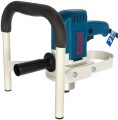Product type
— Mixer. Construction tool for mixing various building mixtures: paint, glue, plaster, mortar, etc. Unlike drill mixers (see below), the functionality of these devices is strictly limited to mixing viscous solutions. But at the same time they are much more powerful, reliable and boast high torque. They can be in demand both in construction and in the household.
—
Drill mixer. This tool combines the functionality of a construction mixer and a classic drill in one relatively compact body, making it a more versatile solution for home use. Usually, all models of this type are equipped with a chuck and support the possibility of installing a mixing nozzle or equipment for drilling holes in wood and other materials. Lighter and more convenient to use when compared with the mixers described above, but at the same time inferior to them in terms of power.
Power consumption
The power consumed by the construction mixer (see "Device") during operation.
High power provides the device with high performance — such a model can easily cope with complex tasks, such as mixing a large volume of mixture at a time or while working with heavy fillers, such as crushed stone. On the other hand, high power affects the power consumption of the device, its weight, dimensions and cost. It makes little sense to purchase a powerful model if you select a tool for domestic use from time to time.
Rotation speed
The rotation speed of the nozzle or mixing container provided by a plaster mixers.
High rotation speed devices work best with paints, varnishes and glues.
Low rotation speed models do a good job of preparing thick mixtures. Many modern plaster mixers and mixer-drills support the ability to adjust the speed (see "Features"), which allows user to choose the most optimal mode for a particular mixture. Powerful tools especially need a rotation under heavy load support system.
Max. torque
The
higher the torque, the better the tool handles viscous masses, where special force is required to turn the mixing nozzle. It is measured in Newtons per metre (N/m). Note that with an increase in the speed of rotation (see "Number of revolutions"), the torque decreases, and vice versa.
Max. mixing paddle diameter
The vast majority of attachments for construction mixers have a standard size in length, usually 600 mm. But their diameter may differ, its maximum size is limited by the manufacturer, which must be considered when choosing. The indicator depends on the technical characteristics of the tool. The most popular sizes are
120mm,
140mm and
160mm nozzles. The larger the diameter of the auger, the easier it can cope with a large volume of mixed mixture.
Reduction drive
The ability to switch speeds allows you to cope with various types of tasks: low speed and high torque are perfect for mixing viscous or heavy mixtures, and vice versa — high speed and low torque are better to cope with liquid materials such as paint, glue, etc.
Note that the support for
two speeds provides the presence of a two-speed gearbox. At the same time, many modern construction mixers with a single-speed gearbox support the ability to smoothly adjust the speed of rotation of the nozzle (see "Functions / Capabilities").
Max. stirred volume
Numerical value, expressed in liters, indicating the maximum volume of solution that the mixer can mix in one step.
Max. wood drilling diameter
Refers to models that the user can also use as a conventional drill for drilling wood or metal. The parameter characterizes the largest diameter of holes that can be made using a tool. Here it should be taken into account that some modern mixers allow you to install drills of a much larger diameter than indicated by the manufacturer, and, theoretically, make a larger hole. But the larger the diameter, the higher the resistance of the material and, accordingly, the power of the device should be large. Using the tool on off-design loads is fraught with breakdowns.
Max. steel drilling diameter
The maximum diameter of a hole that can be made with a particular construction mixer or mixer drill when drilling steel. See "Maximum wood drilling diameter.

